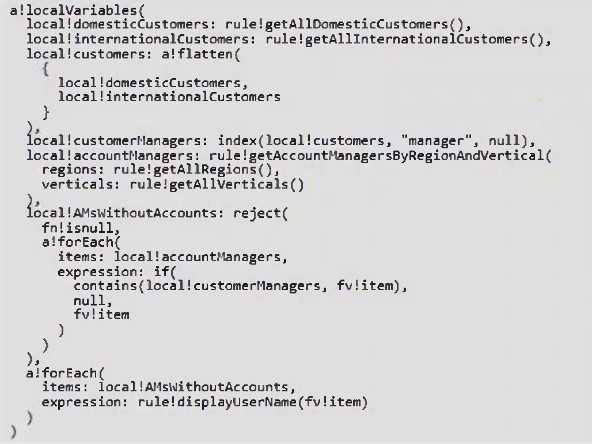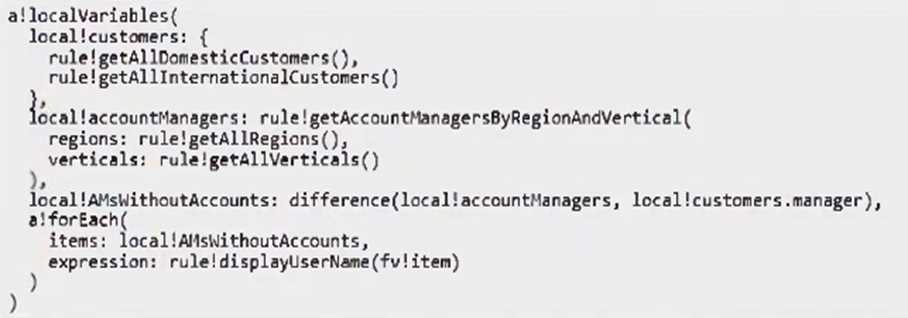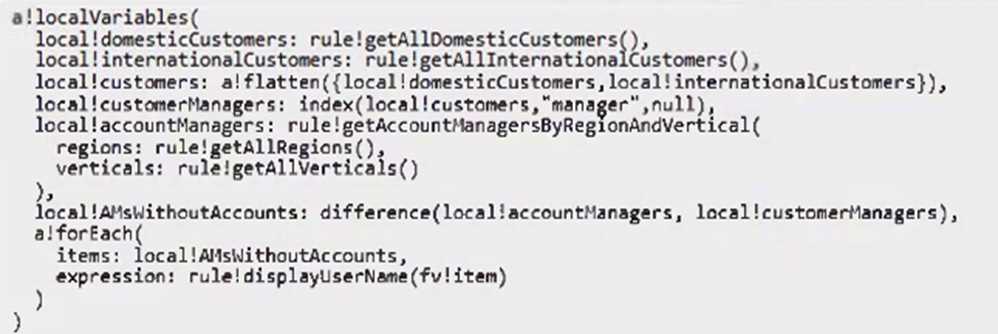appian acd201 practice test
Appian Senior Developer
Question 1
You're developing a functionality to manage transactions for an insurance company. Each transaction
can have multiple items where respective item type and item amount can be entered. The amount
entered can be either negative or positive, and is a decimal data type with a precision of 8 and a
scale of 2.
A maximum of 10 items can be entered for a transaction. Once all the items are entered, you need to
calculate and show the sum of all items' total amounts at the transaction level.
What is the best way to calculate and display the sum of all item amounts?
- A. text(sum(ri!items.amount),"00.00")
- B. fixed(sum(ri!items.amount),2,false())
- C. round(sum(ri!items.amount),2)
Answer:
B
Explanation:
fixed(sum(ri!items.amount),2,false()) is the best option because it returns the sum as a text value
formatted to exactly two decimal places, which is ideal for currency or financial amounts. This
ensures the total displays correctly as a string, maintaining precision and formatting for both positive
and negative values.
Question 2
You’re establishing a Health Check schedule for your department.
Which two statements should you consider when implementing Health Checks? (Choose two.)
- A. Run a Health Check at least once a month in production as part of server and application monitoring.
- B. Run Health Checks during regular business hours in production to identify issues during heavy usage.
- C. Configure a weekly Health Check cadence for the development environment.
- D. Run Health Checks during regular non-business hours in production to avoid slowing down the environment.
Answer:
A, D
Explanation:
Running a Health Check at least once a month in production is best practice for ongoing monitoring
and early issue detection.
Running Health Checks during non-business hours in production helps avoid performance impact on
end users.
Question 3
You're developing a record view for a case management system that enables users to upload files to
a specific location within an external records application.
Your requirements are:
In this record view, there should be a record action that allows the user to upload a file to the
interface and configure the metadata (name, author, file size) before submitting.
If the file is larger than 250MB, the user will be notified that the file will be uploaded overnight.
Once the file has been successfully uploaded, the file will appear on the record view and the user can
interact with the file.
Which two pieces of user-facing information must be captured from this business process so that you
can develop this record view? (Choose two.)
- A. The location of where the file will be uploaded to in the external records application.
- B. The email of the system administrator so that an email can be sent to them if the integration fails.
- C. The time of file upload if the file is less than 250MB.
- D. How the user wishes to interact with these files in the record view - as a grid or a series of card layouts.
Answer:
A, D
Explanation:
You need to know the target location in the external records application to properly upload the file.
Understanding how users want to interact with files (grid or card layout) is essential for designing the
record view interface.
Question 4
You're designing an expression rule that needs to retrieve employees from a database for a given
department and display their full name concatenated with their role in a list for a dropdown field.
Which design approach should you recommend?
- A. Query the data to return all employees. Using a!forEach(), for each item in the list, if the employee belongs to the given department, return the employee name and role, otherwise, return a null value.
- B. Query the data to return all employees. Use wherecontains() to return the employees for the given department and use a!forEach() to return the employee name and role for each item in the list.
- C. Query the data with a filter applied to only return employees for the given department. Using a!forEach(), for each item in the list, return the employee name and role.
Answer:
C
Explanation:
Querying the data with a filter to return only employees for the given department is the most
efficient approach. Then, using a!forEach() to concatenate and return the employee name and role
meets the dropdown display requirement without unnecessary processing.
Question 5
What are three ways to optimize the memory usage of a process model? (Choose three.)
- A. Pass data directly to activity nodes and smart services.
- B. Minimize the use of subprocesses in the model.
- C. Decrease the number of process variables.
- D. Configure process variables as parameters.
- E. Divide large nodes into multiple smaller nodes.
- F. Avoid storing large blocks of text in process variables.
Answer:
A, D, F
Explanation:
Passing data directly to activity nodes and smart services reduces unnecessary use of process
variables, optimizing memory.
Configuring process variables as parameters limits their lifespan and persistence, saving memory.
Avoiding large blocks of text in process variables minimizes memory consumption within the process
model.
Question 6
You're designing an integration object with JSON (application/json) as the content type.
Which two data types can be automatically converted to JSON in Appian? (Choose two.)
- A. Appian Custom data type
- B. Base64 documents inline with JSON
- C. Primitive data types
- D. HTML file type
Answer:
A, C
Explanation:
Appian Custom data types (CDTs) can be automatically converted to JSON for integration.
Primitive data types such as text, number, and boolean are also automatically converted to JSON.
Question 7
You're inspecting the items in a deployment package for issues you might have missed during
package preparation.
Which two objects can be in your list of missing precedents for an application? (Choose two.)
- A. Connected System
- B. Document
- C. Group Type Custom
- D. System Knowledge Center
Answer:
A, C
Explanation:
Connected System and Group Type Custom can both be missing precedents in an Appian deployment
package, meaning dependent objects required by the application may not have been included.
Question 8
You need to configure the security for the synced record type Case.
Your requirements are:
Only users in the "Archive Management" group can access cases in the "Archived" status.
Cases in the status "Deleted" are accessible to no one.
Users in the "All Users" group can already access the record.
What should you do?
- A. Create a new user filter to allow access if the user is in the "Archive Management" group while the case status is "Archived. " Configure the record-level security to exclude all cases that are in the "Deleted" status
- B. Create a new user filter to allow access if the user is in the "Archive Management" group while the case status is "Archived. " Configure a source filter to exclude all cases that are in the "Deleted" status.
- C. Create a new record-level security rule to allow access if the user is in the "Archive Management" group while the case status is "Archived." Configure a source filter to exclude all cases that are in the "Deleted" status.
Answer:
C
Explanation:
Creating a record-level security rule for "Archived" cases restricts access based on user group, and a
source filter ensures "Deleted" cases are excluded from being accessed by any user. This approach
meets both security requirements efficiently.
Question 9
You need to create a web API so that an external system can start a process in your app.
Which two statements are true about using a service account to authenticate the system? (Choose
two.)
- A. The service account must be granted access to that web API via group management.
- B. The service account must be configured from within the web API object.
- C. The service account must be a user in the Service Accounts group.
- D. The service account is created as any other object in Appian.
Answer:
A, C
Explanation:
The service account must be granted access to the web API, typically via group management, to
allow authenticated calls.
The service account must be a user in the Service Accounts group to be used for authentication in
integrations such as web APIs.
Question 10
You're in the process of deploying a package to the client's TEST environment at the end of a sprint.
This package is only relating to changes to a single application.
Which two statements best describes the practices you should follow for automated testing for
expression rules either before or after deploying the package? (Choose two.)
- A. Before using Compare and Deploy, individually evaluate the test cases in the expression rules you intend to deploy. For any failed test case, adjust the expression rule so that it passes.
- B. After deploying the package, you should perform regression testing by running the Start Rule Tests (Applications) smart service to automatically run the test cases. This indicates whether there are any impacts caused by changes to the application.
- C. During Compare and Deploy, the Inspect Deployment tab automatically runs the test cases in each of the expression rules. Review these findings, and either adjust the expression rule or delete outdated test cases.
- D. After deploying the package, you should perform regression testing by running the Start Rule Tests (All) smart service to automatically run the test cases. This indicates whether there are any impacts caused by the changes across multiple applications.
Answer:
A, B
Explanation:
Individually evaluating and fixing expression rule test cases before deployment ensures the new
package does not introduce errors.
Running regression tests after deployment using the Start Rule Tests (Applications) smart service
validates that the deployed changes did not negatively impact the application.
Question 11
You're developing a user input form for a government services application that includes a file upload
component.
If the uploaded file is a multimedia file (for example: .MP4, .MOV or .WAV), the customer wants
these uploaded to Microsoft SharePoint instead.
What is the best way to achieve this requirement?
- A. Use the out-of-the-box Appian Connected System, but since it does not have any pre-built connected systems, you will need to use either a HTTP or OpenAI Connected System to connect with SharePoint.
- B. Develop a connected system plug-in given SharePoint has an extensive API that cannot easily be resolved using the Appian out-of-the-box Connected System.
- C. Use the out-of-the-box Appian Connected System as it has a pre-built connected system to SharePoint to provide a guided experience for designers to send and receive data.
Answer:
C
Explanation:
Appian provides an out-of-the-box pre-built connected system for SharePoint, allowing you to
integrate file uploads to SharePoint with a guided experience for configuration—making this the best
way to fulfill the requirement.
Question 12
Your client reported that a form in the application is very slow to load.
You investigate and find a query entity which is nor performing well.
Which action should you perform to improve query performance for the query entity?
- A. Change the data source of the query entity to a view with a WHERE clause.
- B. Apply indices on all the fields referred in the query.
- C. Apply the appropriate filters and indices in both Appian and the database.
Answer:
C
Explanation:
Applying appropriate filters and indices in both Appian and the database ensures that only relevant
data is retrieved and the database query runs efficiently, improving overall query performance.
Question 13
You need to write an expression to retrieve a list of all account managers who don't currently have an
active customer account.
Which code snippet should you use?
A)
B)
C)
- A. Option A
- B. Option B
- C. Option C
Answer:
B
Explanation:
Chosen snippet uses the difference() function to efficiently get all account managers who are not
currently managers of any customer account. It directly compares local!accountManagers to
local!customers.manager, resulting in a concise and optimal solution for retrieving account managers
without an active customer account.
Question 14
You're creating a new record type with data sync enabled. Users in the "ACME Employees" group
must be able to access the record list and start the New Case action.
What are two valid steps that you should perform to grant users the appropriate access? (Choose
two.)
- A. Add the “ACME Employees" group as a Viewer on the record type.
- B. Add the "ACME Employees" group as a Viewer to the data store mapped to the record.
- C. Grant Viewer permissions to the underlying interface object for the record list.
- D. Grant Initiator permissions to the underlying process model for the New Case action.
Answer:
A, D
Explanation:
Adding the “ACME Employees” group as a Viewer on the record type allows them to access the
record list.
Granting Initiator permissions to the process model for the New Case action enables group members
to start that action.
Question 15
You have designed a three-step 'Wizard' form interaction using user input tasks in the process model.
The second step of the Wizard must utilize another process model which contains a user input task
inside.
Which two methods should be implemented for a seamless Wizard-like interaction for the user?
(Choose two.)
- A. Enable activity-chaining between all nodes on the main process model.
- B. Enable activity chaining between all nodes in the second process model, and activity chain between all user input tasks.
- C. Use a subprocess to call the second process model.
- D. Use the Start Process smart service to call the second process model.
Answer:
A, C
Explanation:
Enabling activity-chaining between all nodes on the main process model ensures the wizard steps
flow seamlessly for the user.
Using a subprocess to call the second process model allows the main process to incorporate its user
input task as part of the wizard flow with activity-chaining support.